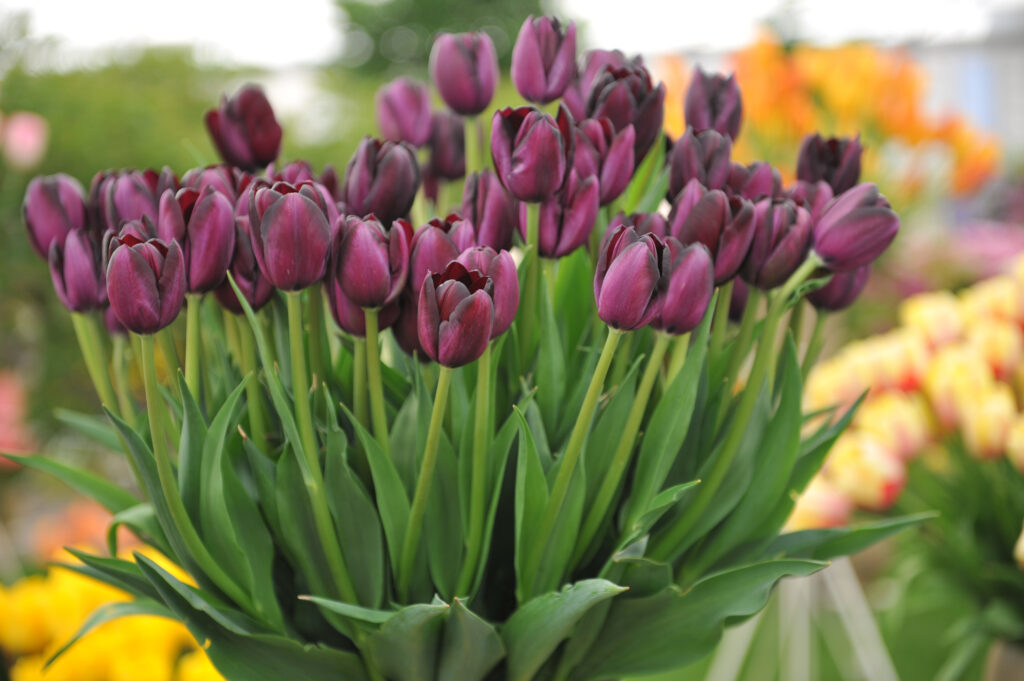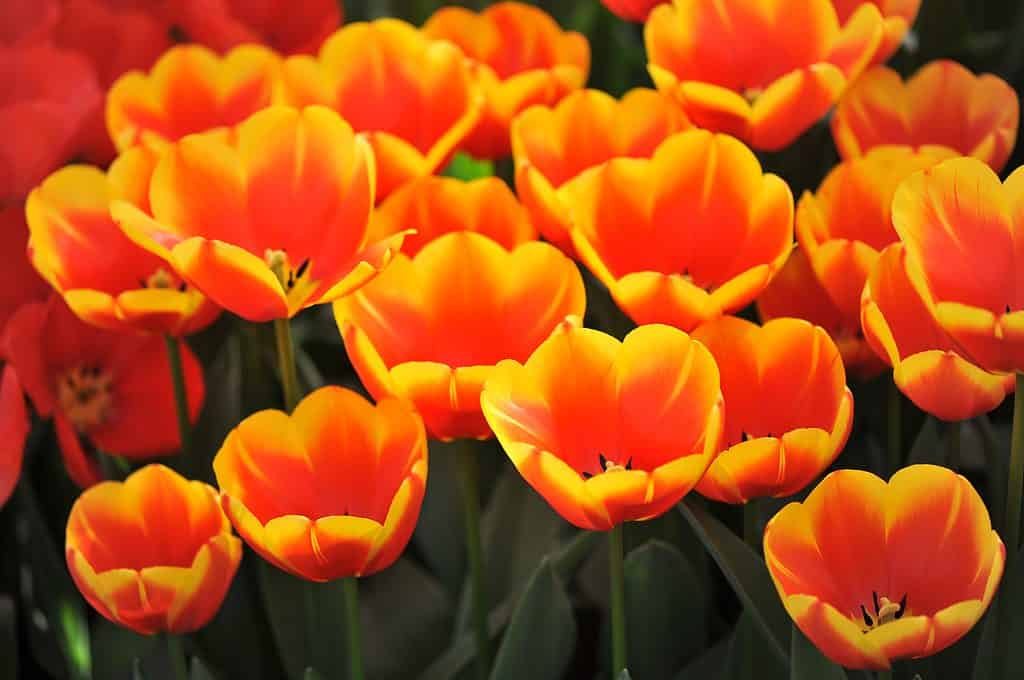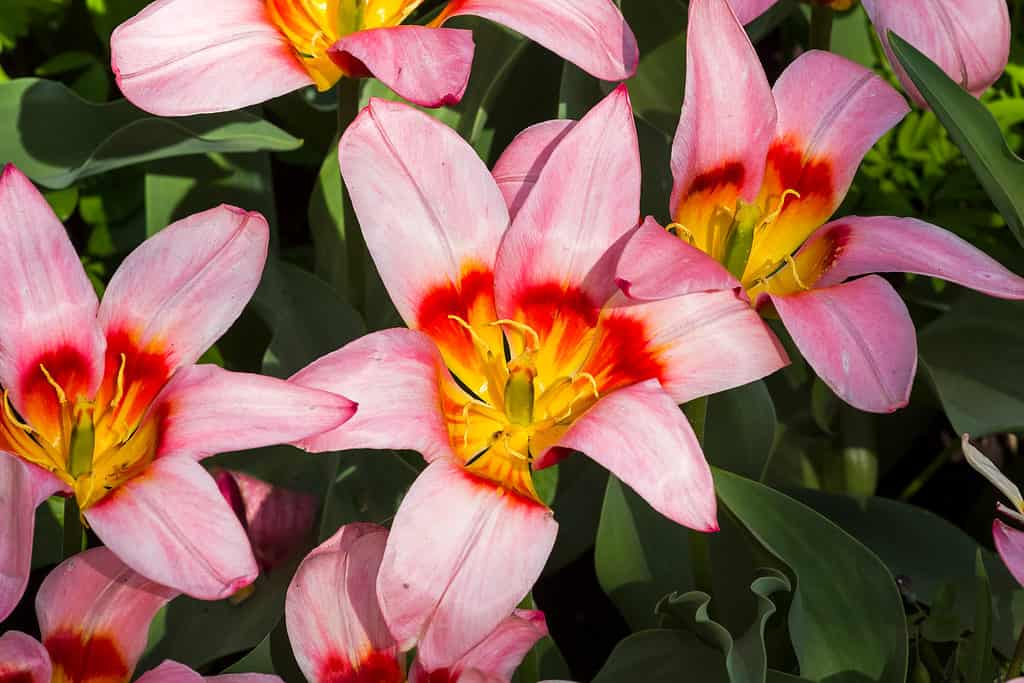Nevada is the driest state in the United States, with an average annual rainfall of only 7 inches. The driest state may not seem like the ideal climate for spring blooms, but with a little preparation tulips can add their special touch to your landscape, and even return year after year!
Winters in northern Nevada are long and cold, while they tend to be short and mild down south. Las Vegas sits within the Mojave Desert and the driest, hottest southern third of the state. Looking to bring a rainbow of spring blooms to your Silver State garden? Read on to find out which tulips do well in Nevada as well as when and how to plant them.
Are Tulips Annuals or Perennials?
When planning for tulip planting, it’s helpful to know whether these flowers are annuals or perennials. Annuals will bloom brilliantly just for the season and then die off, while perennials will go dormant after the growing season and then bloom again the following year. Tulips are native to the steppes of western and central Asia and they perform as perennials in areas similar to their native habitat with cold winters and hot, dry summers.
While tulips are technically true perennials, they’re adapted to many different climates and are often grown as annuals. Whether your blossoms are short and sweet or recurring will depend on your region and growing preference.

Tulips come in 3,000 varieties, divided into 15 groups based on their flower type, size and blooming period.
©Sergey V Kalyakin/Shutterstock.com
3 Tulips Types that Thrive in Nevada
Tulips come in 3,000 varieties, divided into 15 groups based on their flower type, size and blooming period. Hybrid tulips make up the greater majority of these. They usually grow as a single bloom on a long stalk and are often grown as annuals.
The species tulips are smaller in statue and unhybridized. They’ve become more available to home gardeners in recent years. While not native to Nevada, both types of tulips can grow well in Nevada. If you’re looking to naturalize tulips into your garden and have them come back year after year, you might consider a species variety. With proper drainage and full sun they’ll last on and on!
Species Tulips
Species tulips tend to be smaller, thrive in sandy, rocky soils and are more likely to naturalize in the garden as perennials in warm climates. They have more varied foliage and can often have multiple blooms per stem, up to seven in some varieties. They make excellent additions to rock gardens!
The desert tulip (Tulipa systola), with its stunning red blooms and uniquely wavy foliage is an excellent choice. Lady tulips (Tulipa clusiana) bloom pink on the outside, white on the inside and feature a red or purple star at their center. Red-cross tulips (Tulipa pulchella) reach only 3-5 inches in height and feature purple blooms. The late tulip (Tulipa tarda), garden tulip (Tulipa acuminate) and Turkestan tulip (Tulipa turkestanica) are some other species tulips to try. Species varieties will do well all over the state of Nevada, but may be of particular interest to those in the warmest southern regions.

Species tulips tend to be smaller, thrive in sandy, rocky soils and have more varied foliage, often with multiple blooms per stem.
©Mariola Anna S/Shutterstock.com
Darwin Hybrid Tulips
These tulips come in a variety of brilliant colors to color your Nevada landscape. They develop strong stems 20-28 inches tall and long-lasting flowers that are great for bouquets. These are among the most perennial hybrids and will often come back year after year. These hardy tulips are wind and weather resistant and will grow in any region of Nevada.
Desert Sun (Tulipa ‘Desert Sun’), is a variety that lives up to its name with the rich orange and golden yellow hues blending of its petals. There are orange, yellow, red and pink varieties, some with speckles or stripes on their petals. A unique feature of these is the pyramid shape of their immature buds, which is commonly featured in bouquets.

Darwin hybrid tulips come in a variety of brilliant colors to color your Nevada landscape.
©Sergey V Kalyakin/Shutterstock.com
Kaufmanniana Tulips
The blooms of most varieties open up like a star or a water lily. Some develop unique mottled or striped foliage. They bloom in shades of red, yellow, violet, orange and red and have multi-colored interiors. Kaufmanniana tulips are compact growers and can be an excellent addition to a rock garden or used at the edge of your garden as borders. They will grow well in USDA Plant Hardiness Zones 3-7. In warmer Zones 8 and above you can grow them as annuals.
Heart’s Delight (Tulipa kaufmanniana ‘Heart’s Delight’) and Showwinner (Tulipa kaufmanniana ‘Showwinner’) are two stunning varieties to check out.

Kaufmanniana tulips such as the cultivar ‘Heart’s Delight’ open up like a star or a water lily and have multi-colored interiors.
©Sergey Rybin/Shutterstock.com
When to Plant Tulips in Nevada
Planting times will vary slightly by region. Consult the USDA Hardiness Zones Map to determine which Zone you live in. Tulips grow best in Plant Hardiness Zones 3-7, areas with cold winters. The majority of the state of Nevada falls within Zones 4-7. You should plant your tulips in the autumn, roughly 6-8 weeks before a hard frost is expected. In the coldest Zones 3-4, the best time for planting is late September to early October. In the more temperate Zones 5-7, plant them mid-October to early November.
Chilling Bulbs Before Planting for Warmer Climates
If you live in the warmer southern region, Zone 8 or above, you’ll need to create a chilling period for bulbs to bloom properly. Tulip bulbs need to be kept at 35 degrees Fahrenheit to 45 degrees Fahrenheit for a period of 10-14 weeks before planting. This chilling period prompts a biochemical response that sparks flower formation and initiates root growth. You can buy pre-chilled tulip bulbs or you can do the process yourself.
To chill your own bulbs, place them in a refrigerator in a paper bag, mesh bag or egg carton. This is the easiest way to store them at the proper chilling temperature, just be sure to store them separately from fruit. Fruit gives off ethylene gas as it ripens, and will damage the budding flowers that are developing in the bulbs. If you leave them chilling a bit longer than planned don’t worry, they can be chilled longer than the recommended time frame, but shouldn’t be pulled out early. Start the chilling in mid to late October and the bulbs will be ready to plant from December to early January. Be sure to bring them straight from the refrigerator to planting, without letting them warm up!
Warm Climate Pre-Planting
Healthy roots are the basis for beautiful blooms and you’ll want to start your bulbs out right. The tulips types we’ve discussed should work well for Nevada climates. However, if you live in the warmest areas of Nevada, Zones 8 and up, you can take the extra step of pre-rooting before planting. This is especially helpful if you’d like to try some varieties that are less suitable for the climate. Tulips like to begin their root growth in cool soil of about 32-55 degrees Fahrenheit. If you live in an area where the soil temperatures won’t drop below 60 degrees Fahrenheit for long, you can plant your tulips in small containers and keep them cool in a refrigerator for 4-6 weeks.
How to Grow Tulips in Nevada
Tulips like to be planted 6-8 inches deep in cool, well-draining soil. Add a layer of mulch about 2-3 inches thick on top to keep the bulbs cool and retain moisture. If your soil is not well draining or lacks organic material you might consider adding matured manure, compost, or peat moss. Fertilize at planting time in the fall and again in the spring with a low-nitrogen fertilizer like very mature cow manure or a special fertilizer made for spring bulbs.
Tulips in Zones 4-7 should be planted in full sunlight, but in warmer regions they may appreciate partial or even full shade. It’s important to water bulbs right after planting and maintain moist soil so that the roots have time to develop before going dormant until spring. Water often enough that the soil stays moist, but avoid overwatering. If conditions get too soggy it can lead to fungus, disease, rot and other problems.
When Will My Tulips Bloom?
Bloom time will vary considerably by both location and type of tulip. Darwin hybrid tulips are likely to bloom mid-spring, while Kaufmanniana tulips and species varieties will burst forth in-bloom earlier in the spring. You can plant to have a long season full of tulips in-bloom by planting early, mid and late blooming varieties interspersed within your garden bed.
After you’ve enjoyed your blooming tulips for the season and they are beginning to wilt, clip the flower heads to prevent seeding. Let the foliage continue to grow until it turns limp and yellow. The plants will continue to produce energy to prepare for a strong bulb to blossom again next season. Once the foliage is completely limp you can simply remove it by hand or cut it back.
Final Thoughts
Growing tulips in Nevada can be a rewarding endeavor, sure to brighten any spring day. Whether you choose a low-lying bountiful bloom variety or a stalky single-blossom variety you’re sure to find a type to delight your senses. Whether you choose to plant your bulbs each spring or take the steps necessary to naturalize the bulbs to perform as perennials, adding tulips to your gardening routine is sure to pay off in a kaleidoscope of color.
The photo featured at the top of this post is © Printemps PhotoArt/Shutterstock.com
Thank you for reading! Have some feedback for us? Contact the AZ Animals editorial team.






